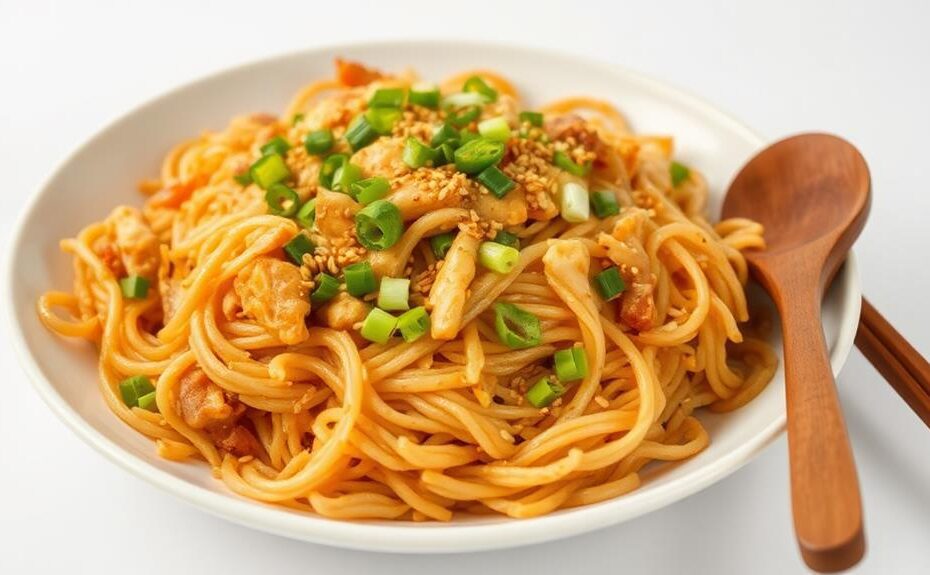Mastering Chicken Pancit Bihon in 10 Steps
Step 1: Prepare Bihon Noodles
Soak bihon noodles in water and mix in soy sauce for added flavor. This step helps to season the noodles and gives them a savory taste.
Step 2: Cook Chicken
Cook tender chicken leg quarters and shred them into bite-sized pieces. This ensures the chicken is fully cooked and easy to eat.
Step 3: Select and Sauté Vegetables
Select a balance of vegetables, such as cabbage, carrots, and green onions, and sauté them to maintain crisp texture. This step adds color, texture, and flavor to the dish.
Step 4: Season with Sauces
Season with soy sauce, oyster sauce, and chicken bouillon cubes for depth of flavor. These sauces enhance the overall taste of the dish and give it an authentic Filipino flavor.
Step 5: Assemble the Dish
Assemble the dish by combining noodles, chicken, and vegetables. This step brings all the ingredients together to create a harmonious and balanced dish.
Step 6: Add a Squeeze of Freshness
Finish the dish with a squeeze of fresh lemon or calamansi juice. This step adds a burst of citrus flavor and freshness to the dish.
Step 7-10: Refine and Serve
Refine the dish by adjusting the seasoning and flavors to taste.
Serve hot and enjoy the fruits of your labor!
Preparing the Noodles
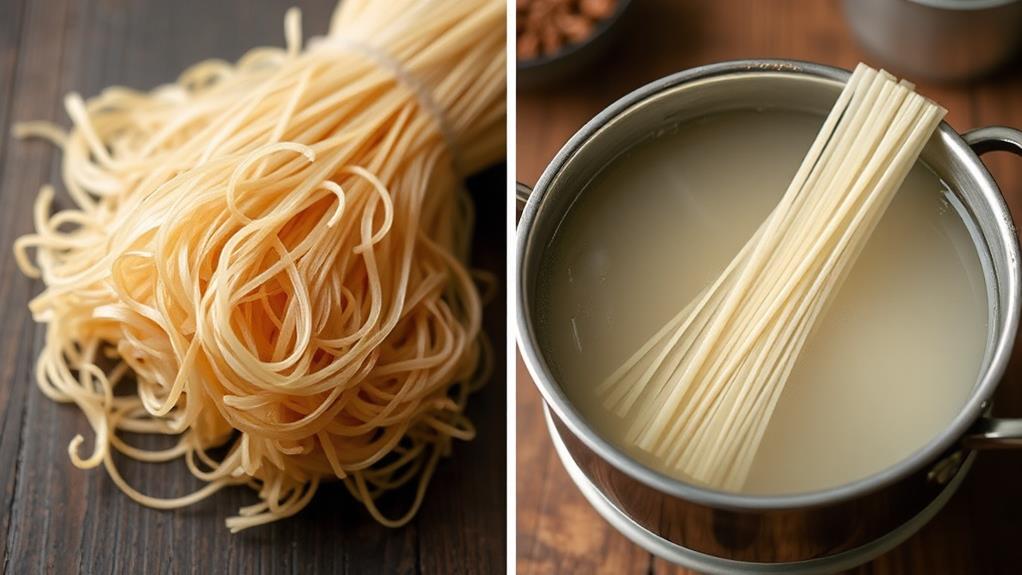
Soaking bihon noodles is essential for tender and flavorful Chicken Pancit Bihon. To do this, submerge 8 oz. of bihon noodles in a bowl of water for 10 minutes or until they become soft and pliable.
It's crucial to check periodically for tenderness and ensure they're fully submerged in water. After soaking, drain any excess water to prevent sogginess.
Separating the noodle strands ensures even cooking. Gently toss the soaked noodles to separate the strands. This step makes a big difference in the final texture of the dish.
Incorporate the prepared noodles into the pan after sautéing the vegetables. This allows the noodles to absorb flavors from the broth and seasonings, resulting in a fully cooked and flavorful Chicken Pancit Bihon.
Cooking the Chicken
Cooking the Chicken
Now that your bihon noodles are ready, it's time to prepare the protein that will elevate your Chicken Pancit Bihon.
Boiling the Chicken
To cook the chicken, boil bone-in chicken pieces in 6 cups of water for approximately 30 minutes until fully cooked and tender. This process not only cooks the chicken but also creates a flavorful chicken stock that can be reserved for the dish.
Using chicken leg quarters ensures rich flavor and moisture.
Checking Doneness
Ensure the chicken is cooked through, as indicated by easy fork penetration. Be careful not to overcook the chicken, as this can lead to dryness.
Shredding the Chicken
After boiling, shred the chicken into bite-sized pieces for easy incorporation into the noodle dish.
Don't forget to strain the chicken bouillon to remove any impurities, resulting in a clear and flavorful chicken stock. This stock will be the foundation of your Pancit Bihon's rich flavor profile.
Selecting Vegetables
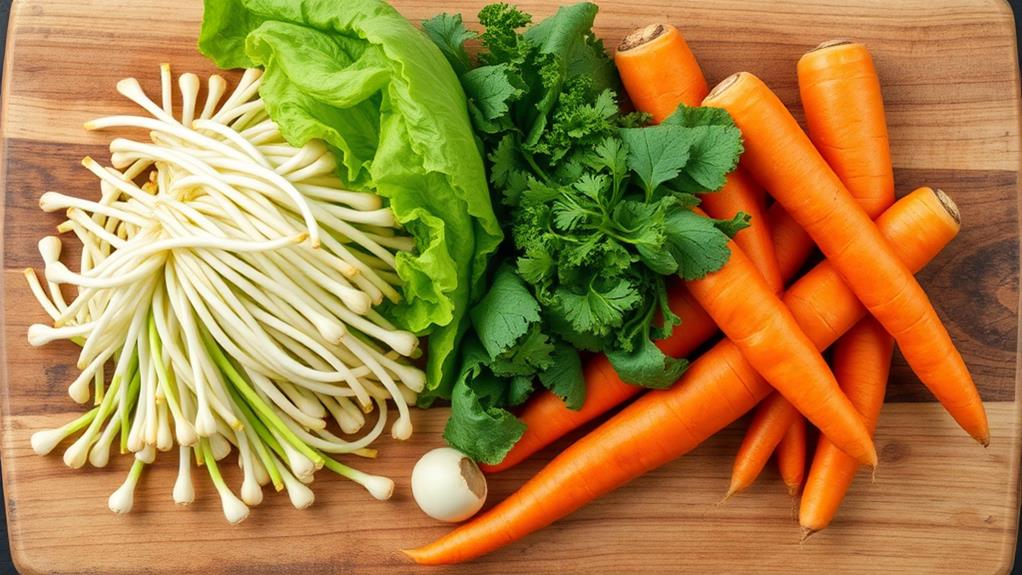
Selecting the Right Vegetables for Chicken Pancit Bihon
Fresh vegetables add essential nutrients and a pop of color to your dish. To achieve a harmonious balance of flavors and textures, aim for a balance that complements the noodles and chicken without overpowering them.
Recommended Vegetables:
- 1/4 cabbage adds crunch and a touch of sweetness.
- 1-2 carrots provide a pop of color and a hint of earthiness.
- A small bunch of parsley adds freshness and a burst of flavor.
Preparing Vegetables:
To enhance flavor and maintain a crisp texture, stir-fry or blanch these vegetables before adding them to your dish.
You can adjust the quantities based on your personal preference, but be mindful not to overwhelm the dish.
Celery and onions can also be sautéed with garlic to create a flavorful base before adding the main ingredients.
Seasoning With Flavor
Building the Flavor Foundation
To create a robust flavor profile for your Chicken Pancit Bihon, thoughtful seasoning is essential. A combination of seasonings and techniques is necessary to achieve a well-rounded taste.
Soy Sauce and Oyster Sauce
2-3 tablespoons of soy sauce and 1-2 tablespoons of oyster sauce are used to infuse flavor and enhance the overall taste of the dish. Apply these seasonings to the chicken before cooking to maximize their effect.
Garlic and Onions
A fragrant base is created by sautéing 2-3 cloves of crushed garlic and 1/2 onion in oil. This elevates the flavor of the entire pancit.
Chicken Bouillon Cubes
1-2 chicken bouillon cubes are added to the cooking water to provide an added depth of flavor, particularly when using plain water for boiling the chicken.
Salt and Black Pepper
Salt and black pepper are used to balance the flavor of the dish. Adjust these seasonings to taste, ensuring a well-rounded flavor profile without overpowering the other ingredients.
Zesty Finish
For an added burst of flavor, serve the pancit with calamansi or lemon wedges on the side. This allows diners to squeeze fresh juice over their portions.
Soaking Noodles
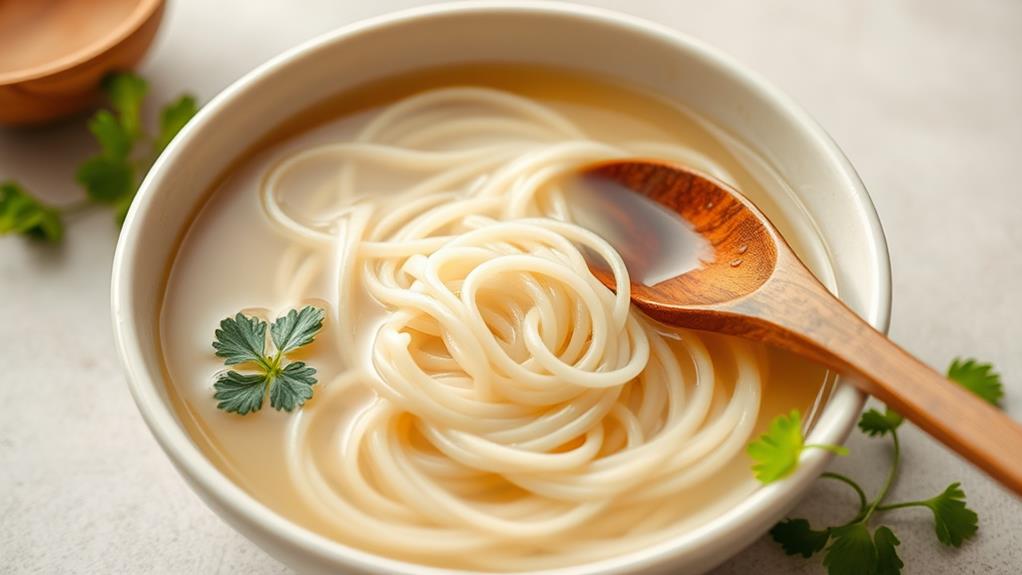
Soaking Noodles for Perfect Texture
To prepare pancit bihon noodles, a critical component of this dish, soaking is a crucial step. It requires attention to detail to achieve the perfect texture.
Soak in Water
Submerge the pancit bihon noodles in a large bowl of water for 10-15 minutes until they become soft and pliable. Ensure the bowl is large enough to accommodate the noodles, allowing them to fully submerge in water.
Monitor and Adjust
Periodically check the noodles during soaking to ensure they don't become overly soft, as they'll continue to cook during stir-frying.
Drain and Flavor
After soaking, drain excess water to avoid making the dish too soggy when combining with other ingredients.
For added flavor, mix in 3 tablespoons of soy sauce with the drained noodles before incorporating them into the stir-fry.
Cooking the Vegetables
Cooking the Vegetables
To achieve a balanced flavor profile in Chicken Pancit Bihon, stick to minimal varieties of vegetables. The recommended vegetables are cabbage, carrots, and celery.
Vegetable Quantities and Preparation
| Vegetable | Quantity | Tips |
|---|---|---|
| Cabbage | 1 cup | Slice into thin strips to cook evenly |
| Carrots | 1 cup | Peel and slice into bite-sized pieces |
| Celery | 1 cup | Slice into thin strips, removing seeds and leaves |
Sautéing the Vegetables
Preheat your wok or large pan on medium heat. Add about 2 tablespoons of cooking oil to ensure even sautéing of the vegetables. Start by sautéing crushed garlic and sliced onions until fragrant, then add the other vegetables. Stir constantly to prevent burning and promote even cooking. Adding a small amount of water or chicken broth helps to steam the vegetables, resulting in a tender texture without losing nutrients.
Assembling the Dish
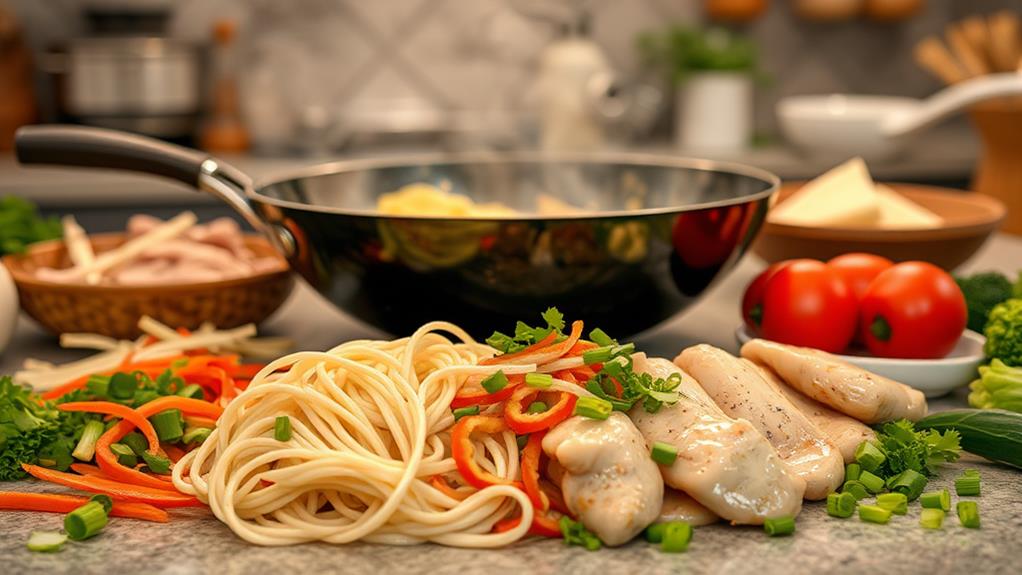
Assembling the Dish
To create a harmonious and savory Chicken Pancit Bihon, the components must be brought together correctly.
Soaking and Cooking the Noodles: Soak 8 oz. of pancit bihon noodles in water for 10 minutes to soften them. This ensures they're easily separable for even cooking.
Combining the Broth and Chicken: In a large pan or wok, combine 2 cups of chicken broth or 2 dissolved chicken bouillon cubes with the shredded chicken.
Heat the mixture through to allow the flavors to meld.
Uniting the Flavors: Add the soaked noodles to the pan and mix in 3 tablespoons of soy sauce to evenly distribute the flavors.
Cook for about 5 minutes until the noodles absorb the liquid.
Adding Final Touches
Adding Final Touches
With your Chicken Pancit Bihon nearly complete, it's time to add the finishing touches that elevate this dish from good to great.
To enhance flavor and freshness, squeeze fresh lemon or calamansi juice over the dish just before serving. To add color and texture to the presentation, garnish with chopped green onions or additional sliced vegetables.
| Step | Action | Purpose |
|---|---|---|
| 1 | Squeeze fresh lemon or calamansi juice | Enhance flavor and freshness |
| 2 | Garnish with chopped green onions or vegetables | Add color and texture to presentation |
| 3 | Serve hot | Maintain noodle texture and peak flavors |
To present the dish attractively, arrange the noodles in a large serving platter, highlighting the vibrant colors of the vegetables and proteins. To accommodate individual tastes, consider offering extra soy sauce or fish sauce on the side for guests who may want to adjust the seasoning to their taste.
Serving Suggestions
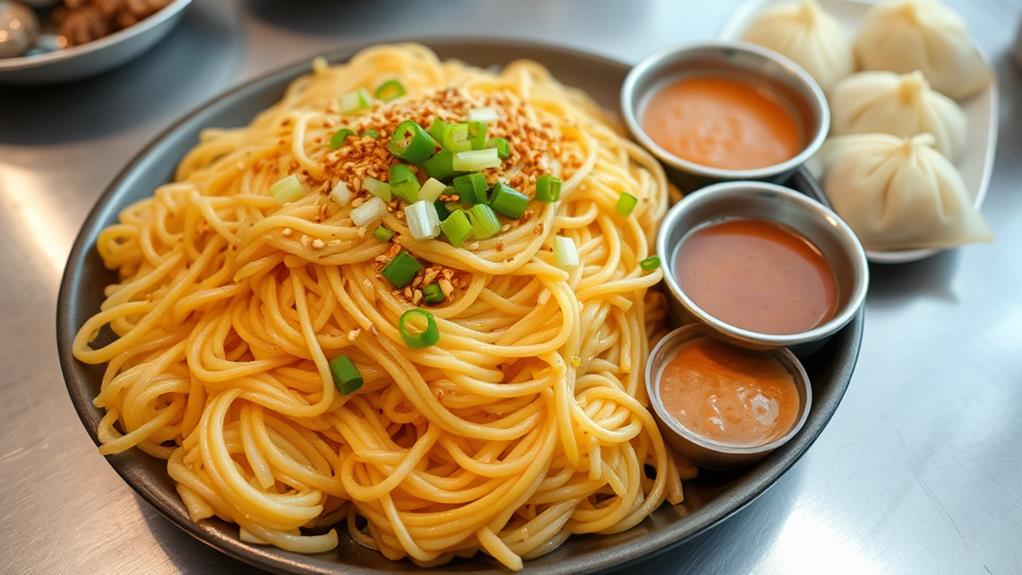
Serving Suggestions
Presentation Matters: To make a memorable impression with your Chicken Pancit Bihon, pay attention to how you serve it. This Filipino dish deserves to be presented in a way that showcases its flavors and textures.
Elevate Your Serving Game: Follow these suggestions to elevate your serving game:
Garnish with Flavor: Serve the Chicken Pancit Bihon hot, garnished with fresh lemon wedges or calamansi for a zesty flavor enhancement.
Add Visual Appeal: Consider adding sliced scallions or chopped parsley as a colorful and flavorful garnish to elevate the dish's presentation.
Communal Dining Experience: For a communal dining experience, present the Pancit Bihon in a large serving platter, encouraging guests to serve themselves.
Pair with Traditional Sides: Pair the dish with traditional Filipino side dishes like lumpia (spring rolls) or adobo for a complete meal.
Brighten the Flavors: Encourage diners to squeeze lemon or calamansi juice over their portions right before eating to brighten the flavors of the dish.
Nutrition and Variations
Pancit Bihon's Nutritional Profile
Pancit Bihon provides a significant amount of carbohydrates and protein. A single serving contains approximately 70g of carbohydrates, accounting for about 23% of the daily value.
The protein content varies depending on the choice of protein, but using chicken meat increases the protein content to about 31g per serving, equating to 62% of the daily value.
Vitamins and Minerals
The vegetables in Pancit Bihon, such as cabbage and carrots, contribute essential vitamins and minerals. A single serving offers significant amounts of Vitamin A (4140 IU) and Vitamin C (39.8 mg).
Variations
There are variations of Pancit Bihon that cater to different dietary preferences. Pancit Canton, which uses egg noodles, provides a heartier texture and additional protein.
For a healthier option, Pancit Bihon can be made vegetarian by substituting meat with tofu or an array of vegetables, maintaining a balanced nutritional profile.
These variations make Pancit Bihon a versatile and nutritious meal option.
Frequently Asked Questions
Can I Use Other Types of Noodles Besides Bihon Rice Noodles?
You can use other types of noodles besides bihon rice noodles. However, keep in mind that alternative noodle options will change the dish's character.
Wheat flour noodles will alter the texture, making it chewier. If you want to explore cultural variations, Japanese soba or Korean naengmyeon noodles can work.
Gluten-free substitutes are available, including rice-based or mung bean noodles.
How Do I Prevent the Noodles From Becoming Too Mushy?
To prevent noodles from becoming too mushy, monitor cooking time closely.
Cooking time greatly affects broth absorption, and insufficient or excessive cooking can lead to uneven texture.
Aim for an al dente texture, where noodles still retain some bite.
This can be achieved by tasting as you go and adjusting cooking time and broth levels accordingly.
For example, if you're cooking ramen, aim to cook it for 2-3 minutes, or until the noodles have a slight resistance in the center.
Can I Add Other Protein Sources Like Shrimp or Pork?
You can add other protein sources like shrimp or pork to your dish, but it requires balance.
When combining proteins, it's essential to adjust cooking times and seasonings to ensure harmony.
Shrimp adds a sweet, pop-of-flavor contrast, while pork brings richness. To tie the protein combinations together, use flavor enhancements like soy sauce, garlic, and ginger.
Be mindful of the overall flavor profile you're aiming for to avoid overwhelming the dish. This means considering the cooking times, seasonings, and flavor profiles of each protein to create a balanced taste experience.
What Is the Ideal Ratio of Noodles to Vegetables?
The ideal ratio of noodles to vegetables is 2:1.
This balance allows each bite to have a pleasant noodle texture, a variety of vegetables, and a harmonious flavor balance.
Allocating 2/3 of the serving size to noodles and 1/3 to vegetables ensures each serving is satisfying without overwhelming the palate.
Can I Make Chicken Pancit Bihon Ahead of Time for Meal Prep?
Yes, you can make chicken pancit bihon ahead of time for meal prep, but proper storage and reheating are crucial to maintain its quality.
To keep your cooked noodles and chicken fresh, portion them into airtight storage containers.
When reheating, use low heat to prevent the noodles from becoming mushy. Adding flavor enhancements like soy sauce or sesame oil can also revive the dish and make it taste fresh again.
